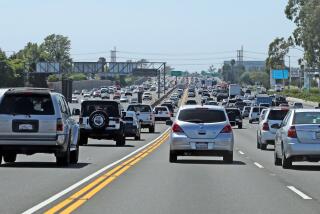Bill Requiring Cyclists to Use Helmets Gains
SACRAMENTO — Efforts to enact a motorcycle helmet law in California--resisted by legislators for two decades--gained considerable headway Wednesday when the Assembly Ways and Means Committee approved a hotly fought bill to require that every motorcycle rider wear a helmet.
The measure was sent to the full Assembly on a 12-9 vote in an atmosphere far less emotionally charged than a hearing last month by another committee when hundreds of burly, leather-garbed motorcyclists turned out to protest the bill.
By contrast, only a handful of bikers appeared for Wednesday’s session, although the committee reported receiving an estimated 10,000 letters opposing the measure.
Emotional Testimony
Among those who did testify was Linda Barber, a petite mother of two and owner of the ultimate motorized macho symbol--a Harley-Davidson--who choked back tears as she lectured the committee on her right to ride unfettered regardless of the risks.
Acknowledging that she had sustained serious injuries in several highway accidents, Barber said: “I’m just a person who rides and wants the freedom of choice.”
In the end, however, arguments over personal freedom gave way to claims that taxpayers are being forced to pay the price of a growing number of motorcycle accident victims who find themselves on public assistance.
“Taxpayers are being dinged in this state $65 million a year and I think that’s a substantial amount of money,” Assemblyman Richard E. Floyd (D-Hawthorne), the bill’s author, said of the cost of motorcycle injuries to the state’s financially strapped Medi-Cal system.
Cites Accident Costs
“If you can save one-tenth of one percent of everything that taxpayers pay, like medical costs and highway costs, we would be the best fiscal conservatives and they’d erect a statue to us.”
According to the California Highway Patrol, there were 801 fatalities and 27,325 injuries from motorcycle-related accidents in 1985 on the state’s highways. However, no one is sure of the exact cost of caring for the victims.
Also, there are no firm statistics on the percentage of the 800,000 licensed motorcyclists in California who wear helmets voluntarily. State law already requires helmets for motorcycle passengers aged 15 1/2 and younger.
The CHP contends that while motorcycles represent only about 3.6% of all vehicles on the roads, they account for 16% of all highway deaths. Studies also show motorcycle deaths on the increase nationwide. Although there is still strong resistance within the Legislature to forcing safety measures on a sometimes unwilling public, lawmakers in recent years have shown less reluctance to do so.
Stringent Seat Belt Law
Last year, the Legislature agreed to impose a $2 surcharge on motorcycle registrations and to use that money for motorcycle safety education programs. In 1985, California enacted one of the nation’s most stringent seat belt laws, not only requiring motorists to use the belts but threatening fines to car manufacturers who fail to install air bags in all new California cars beginning in the next decade.
In arguing for the motorcycle helmet bill, Assemblyman Mike Roos (D-Los Angeles) told committee members, “If you voted for the seat belt bill you ought to vote for this one as well.”
Other committee members, mainly conservative Republicans, continued to opt for personal choice. Assemblyman Gil Ferguson (R-Newport Beach) strongly indicated in his questioning of the bill’s author that he sees the measure as a blatant attempt to enrich a few motorcycle helmet manufacturers.
“If (safety) is what you’re concerned about, why not outlaw smoking?” Ferguson asked Floyd, a heavy smoker. “What we’re talking about here is freedom of individuals not to wear helmets, especially when they are not hurting anyone but themselves.”
Bucking National Trends
If California eventually adopts a mandatory helmet law, it will be bucking national trends. In the mid-1970s, 47 states and the District of Columbia had similar laws on the books but most have since rescinded them. Today only 19 states require all motorcycle riders to wear helmets.
The downward trend began at the same time the federal government rescinded a law, in effect from 1966 to 1976, that threatened to cut highway funds for states without mandatory helmet laws.
More to Read
Sign up for Essential California
The most important California stories and recommendations in your inbox every morning.
You may occasionally receive promotional content from the Los Angeles Times.










